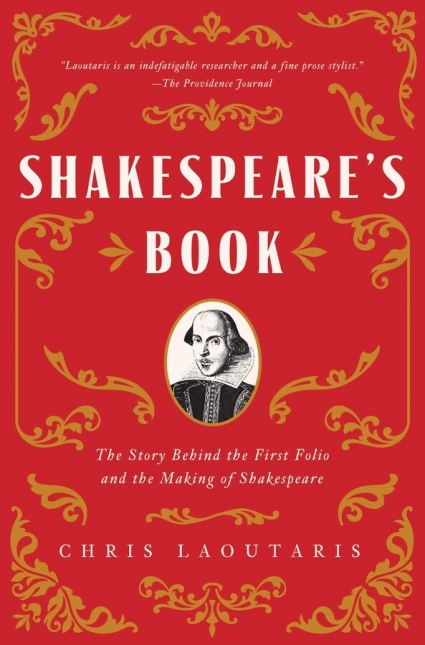Shakespeare’s Book: The Story Behind the First Folio and the Making of Shakespeare
- By Chris Laoutaris
- Pegasus Books
- 560 pp.
- Reviewed by Bob Duffy
- June 7, 2023
A superb account of how the Bard’s compendium came to be.

When he died in 1616, William Shakespeare left behind a circle of prominent admirers: actors, playwrights, poets, and patrons among the nobility and even on the throne. Critically, the circle also included printers and booksellers.
Notable members of this select company, including fellow poet/playwright Ben Jonson, hit upon a singular means of honoring Shakespeare’s memory: publishing a collection of all his plays, an unprecedented tribute. This volume, issued some seven years after his death, has become known as the First Folio, and it’s the subject of Chris Laoutaris’ Shakespeare’s Book, a masterful and engaging study of the circumstances surrounding the volume’s creation, as well as its historical setting and physical production. It’s also impressively readable, written with pace and assurance.
Among the printers and booksellers of the time, a large-format “folio” edition like this was a big deal: only Jonson, among English playwrights, could claim an omnibus folio of his works, but Ben’s volume featured poetry along with plays. Though the literati tended to consider plays as creations of secondary worth, Shakespeare’s folio was to include dramatic works only, a remarkable assertion of their perceived value.
As Laoutaris retells the saga, it’s no surprise that it took the syndicate of Shakespeare’s friends so long to get the First Folio into readers’ hands. Preparing and producing the book required many steps. In the first place, there was Jacobean London’s bureaucracy for registering secure copyright amid the city’s helter-skelter theater culture. What’s more, establishing a text faithful to the Bard’s intent for a given play could itself be challenging, if not befuddling, as widely variant copies were often in circulation. These might include earlier printed versions of single plays, theatrical prompt-books, multiple performance transcriptions, disparate actors’ texts, and even Shakespeare’s own manuscripts or drafts.
As distinct from more compact “quarto” or “octavo” versions — which, due to their unique pre-press requirements, permitted greater economies of scale in the printing process — a folio edition meant a substantially larger finished size and a much heftier price tag. Laoutaris identifies a contemporary buyer, presumably typical, who paid £120 for Shakespeare’s book. In today’s money, this equates to “roughly a year’s wages for the average labourer.” The customer in question, one Thomas Longe, was likely no laborer, at least by trade.
Laoutaris reconstructs each stage in the physical production cycle — editing, pre-press composition, and printing — in clear and fascinating detail. Citing previous analyses, he summarizes how certain identifiable compositors, anonymous but betraying themselves through the traces of their individual technique and vagaries in spelling, personally typeset which of the plays — and even which sections of the plays.
Shakespeare’s Book marshals a wealth of related historical detail, too, illuminating, for instance, how the aspiring publishers of the First Folio — or at least a ruling plurality of them — fine-tuned their endeavor to buttress King James’ foreign policy. Many in the syndicate apparently calculated that the support of the king and his circle, potential dedicatees of the planned folio, was essential to its commercial success. The king was determined to marry his son Charles to the Duenna, the flower of the Spanish royal line.
Known as the “Spanish Match,” this dynastic strategy had become a matter of some controversy among the English public, with many concerned about — and possibly experiencing déjà vu over — the threat of Catholicism creeping back into British life. (The pope, his pontifical gaze on the match, was reportedly polishing up the usual dispensations, should the king ease up on the sanctions against Catholic worship.)
The hoped-for betrothal ultimately fell through (largely in the face of the Duenna’s underwhelming enthusiasm for a Scottish bedmate), but not before the First Folio’s publishers nailed down an order of presentation that hinted at the wisdom of King James’ “treasured Spanish project.” The folio begins with a late play, The Tempest, which “may have been placed as the headline work because, as one scholar put it, the play exemplified ‘conflict resolution through dynastic marriage.’”
Significantly, the compendium concludes with Cymbeline, which, Laoutaris writes, “created a potent narrative arc across the whole volume, resolving on a play which staged an accord between two ancient powers, Britain and Rome, in a manner that must have recalled James I’s vision for a grand Anglo-Spanish union.” While the king’s proposed match went awry, the order of presentation of the plays stayed, with the folio dedicated to two royal advisors who happened to be vocal opponents of the marriage.
Shakespeare’s Book is sure to take its place among this century’s most valuable contributions to Shakespearean studies. By showcasing this unprecedented compilation, Laoutaris draws attention to the First Folio’s importance to our awareness and appreciation of the English language’s premier poet.
Bob Duffy, a reconstituted scholar of the Renaissance who can’t seem to shake the bug, reviews frequently for the Independent.

